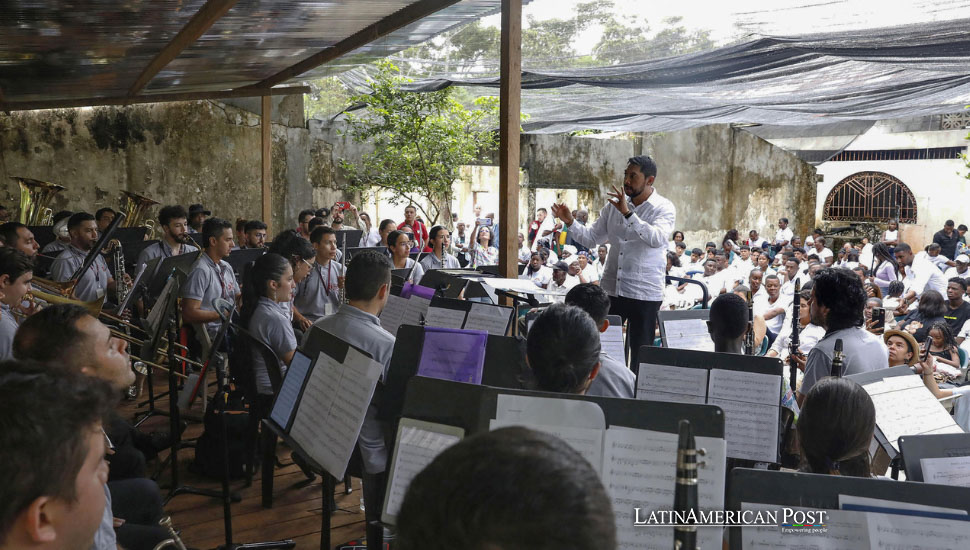Art and Music Heal Open Wounds of Bojayá, Colombia Massacre

In Bojayá, Colombia, a community marks 22 years since a devastating massacre with a ceremony of hope, utilizing art and music to foster peace and remember the over one hundred lives tragically lost.
In the remote town of Bojayá, located in Colombia’s Chocó department, a poignant ceremony unfolded, commemorating the 22nd anniversary of a massacre that claimed over a hundred lives. The community, consisting mainly of Afro-descendant and Indigenous peoples, gathered to remember the victims and turn a page toward healing through cultural expression.
A Tragic Turning Point
On May 2, 2002, during intense clashes between FARC guerrillas and paramilitaries, a church where many had sought refuge was struck by a homemade gas cylinder bomb. The attack left deep scars on the community, physically and emotionally, but it also forged a powerful resolve among the survivors.
In a striking display of resilience, the Bojayá community, alongside government representatives from the Ministries of Culture and Education, dedicated the day to “reparation, reconciliation, and non-repetition.” The focal point of the commemoration was a pilgrimage with the Cristo mutilado, a revered religious icon from the church that survived the bombing. This symbol of resistance and endurance led a procession through the town, encapsulating the community’s ongoing journey from pain to healing.
The event was about remembrance and looking forward, as articulated by a group of women Cantadoras de Pogue who sang for peace, their hands clutching white paper doves. Their songs echoed the sentiment that despite their grief, the community’s spirit remains unbroken, with music serving as both a salve and a strengthener of communal bonds.
Antonio Suárez, executive director of the National Association of Symphonic Music, emphasized the transformative power of music in rebuilding social fabric. “Music plays a crucial role in the reconstruction of Colombia’s social fabric,” Suárez stated, reflecting a broader recognition of the arts as vital tools in post-conflict community recovery.
Empowering Youth Through Music
Building on this theme, the commemorative event also saw the launch of ‘Sonidos para la construcción de paz’ (Sounds for Peace Building), a new initiative to nurture creativity and peace-oriented skills among the youth. Gabriel Arjona, the program’s national manager, highlighted that the initiative goes beyond mere music lessons to foster creativity conducive to sustained peace.
This year, the program is set to reach 1,590 educational establishments across 687 municipalities in Colombia, aiming to impact over 300,000 children, adolescents, and youths. Specifically, in Bojayá, efforts will concentrate on three educational institutions, integrating music and cultural activities to offer a comprehensive approach to healing and learning.
Despite the focus on cultural and educational advancements, local demands remain, including improved electricity services and better connectivity with the rest of the country. These requests underscore the ongoing challenges faced by a community eager to progress yet hindered by infrastructural deficits.
The setting of the commemorations, Old Bojayá, stands as a stark reminder of the massacre’s lasting impact. Mostly abandoned, with fewer than 15 residents, its dilapidated buildings and a flooded football field greeted visitors who arrived by boat. This poignant backdrop added a layer of solemnity to the day’s events.
José de la Cruz Valencia, a community leader and Bojayá native, expressed a desire to transform the town into a site of memory and learning for Colombia. “We want to turn the municipality, where so many of our people unjustly shed their blood, into an example of peace-building in the country,” de la Cruz explained. He sees the ruins as not just remnants of a painful past but as mighty messengers speaking to the brutalities of Colombia’s conflict.
A Model for Resilience
The events in Bojayá illustrate a broader narrative across Latin America, where communities leverage cultural heritage and artistic expression to navigate the legacies of violence. In places like Bojayá, art and music have emerged as vital components of community resilience and peace-building, offering a model for conflict-affected regions worldwide.
Also read: Colombia’s Silvestre Dangond Elevates Vallenato in Medellín Spectacle
As Colombia grapples with the echoes of its violent past, the story of Bojayá stands as a testament to the power of communal memory and the arts as catalysts for healing and hope. Through initiatives like ‘Sonidos para la construcción de Paz,’ Bojayá remembers its lost loved ones and charts a course toward a more harmonious future.




